Reinsurance is a type of insurance wherein part of the risk taken by an insurance company is taken on by another insurance company. When one reinsurance company has other reinsurance companies partially underwrite some of the reinsurance risks, it essentially diversities its risk portfolio and limits its potential losses as a result of a Catastrophe. These payments are often not disclosed to clients although they use client money. For example, if a hurricane causes widespread damage to businesses, homes, automobiles, and lives, a single insurer could face bankruptcy without retrocession.
This process also protects the initial reinsurer and ensures that there are available funds when a huge amount of claims needs to be paid out. Therefore, this system encourages advisers to promote funds or products because they will receive a fee, not because the funds are the best option for the client.
Types of Retrocession
There are three types of retrocession fees:
- Custody banking retrocession fees. Here, a wealth manager receives compensation for attracting a new customer and that customer’s investment to a custody bank.
- Trading retrocession fees. They are paid as compensation for various trading transactions such as securities trading.
- Financial product purchase retrocession fees. In finance, retrocession fees are often attached to investment funds.















